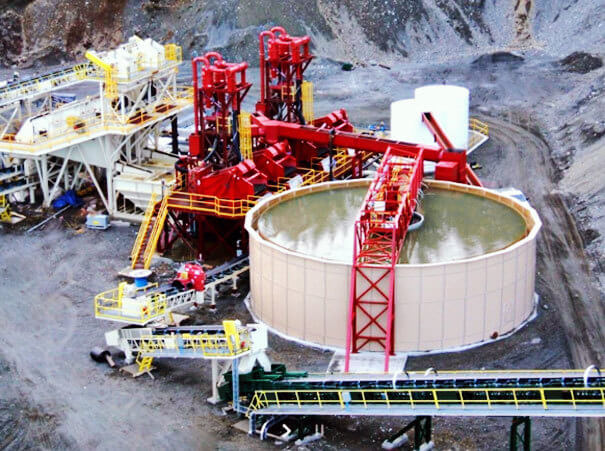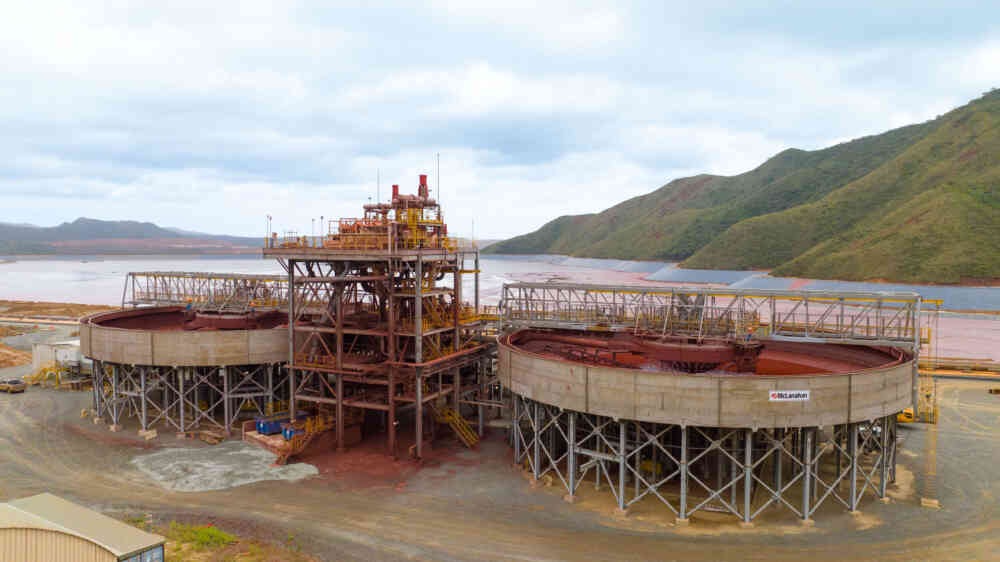Introduction
With growing emphasis on environmental responsibility and sustainable mining practices, effective tailings management has emerged as a key focus for the industry. Modern methods for handling tailings depend significantly on equipment like thickeners and filter presses, which are essential for solid-liquid separation and minimizing the ecological footprint of tailings disposal.
What Are Thickeners?
Thickeners are large, cylindrical vessels designed to separate solids from liquids within a slurry through the process of sedimentation. This involves allowing the solid particles to gradually settle to the bottom under the force of gravity, while the clarified liquid, or overflow, is collected from the top. The primary goal of using thickeners is to decrease or even eliminate the reliance on traditional waste containment methods like settling ponds.
As the solids settle, they form a denser material known as the underflow, which is discharged from the bottom of the tank. By concentrating the solids and reducing the liquid volume, this method enhances the safety and efficiency of tailings management.
What Are Filter Presses?
Filter presses are mechanical devices used to separate solids from liquids by applying high pressure to a slurry. The slurry is pumped into a series of filter plates lined with filter cloths. As pressure builds, the liquid is forced through the cloth and exits as filtrate, while the solid particles are retained, forming a compact “filter cake” between the plates.
This method is highly effective for producing tailings with very low moisture content, which reduces the risk of leakage and simplifies transportation and storage. Filter presses are especially useful when dry stacking is the preferred method of tailings disposal, supporting safer and more environmentally responsible operations.

The Importance of Thickeners and Filter Presses in Tailings Management
In today’s mining operations, effective tailings management is critical for minimizing environmental risks, complying with regulation and optimizing resource use. Thickeners and filter presses are key technologies in this process, helping to reduce water consumption, minimize tailings volume and improve the overall safety and sustainability of mine waste handling. Each plays a unique but complementary role in dewatering and stabilizing tailings before final disposal.
Thickeners
Thickeners contribute to tailings management by significantly reducing the water content in the slurry at an early stage. By concentrating solids and producing thick underflow, thickeners reduce the volume of waste that needs to be stored or further processed. This not only lessens the load on the downstream equipment like filter presses but also helps conserve water for reuse in the plant. Thickeners are especially valuable in operations looking to reduce reliance on large-scale tailings ponds.
Filter Presses
Filter presses take the dewatering process a step further by producing tailings with minimal residual moisture. This results in a dry, stackable material that is easier and safer to store, particularly in areas where tailings dams pose environmental or geotechnical risks. By producing drier tailings, filter presses also help prevent water loss, reduce leachate generation and contribute to a more circular approach to resource management by enabling water reuse and more efficient material handling.
Types of Thickeners Used in Tailings Management
Different mining operations require different thickening technologies depending on factors like tailings composition, throughput requirements and environmental constraints. Several types of thickeners are commonly used in tailings management, each offering specific advantages in performance, space efficiency and water recovery.
1. Conventional Thickeners
Conventional thickeners are large, open-topped tanks equipped with a rotating rake mechanism that slowly moves settled solids toward the discharge point. They are relatively simple and cost-effective but typically require a large footprint and offer lower solids concentration compared to other designs.
2. High-Rate Thickeners
High-rate thickeners improve on the conventional design by incorporating feedwell modifications and flocculant dosing systems to accelerate particle settling. These thickeners achieve faster throughput and require less space, making them a popular choice for operations looking to optimize processing efficiency.
3. High-Density Thickeners
High-density thickeners produce a more concentrated underflow by operating at higher torque and incorporating steeper tank walls and rake mechanisms designed to handle denser materials. This reduces the load on downstream equipment and is ideal for processes that aim to reduce tailings volume significantly.
4. Paste Thickeners
Paste thickeners are designed to produce a highly viscous, nearly non-settling underflow known as paste. This type of thickener is especially valuable for operations that practice paste backfilling or dry stacking, as it maximizes water recovery and minimizes the risk of tailings dam failure.

Types of Filter Presses Used in Tailings Management
Filter presses come in various designs to suit the specific needs of different mining operations. The type of filter press selected depends on factors such as desired moisture content, capacity, cycle time and the nature of the slurry being processed. Each type offers unique advantages in terms of efficiency, automation and suitability for high-volume or high-solids applications.
1. Plate and Frame Filter Presses
This traditional design consists of alternating plates and frames held together in a series. Slurry is pumped into the spaces between the plates, where solids are captured and form a cake, while liquid filtrate passes through the filter media. While relatively simple and effective, plate and frame presses are less common in modern mining due to slower cycle times and lower levels of automation.
2. Recessed Plate Filter Presses
Recessed plate presses use molded plates with a built-in cavity that forms a cake chamber. This design allows for higher pressure filtration and faster cycle times compared to plate and frame presses. They are widely used in mining due to their ability to handle large volumes and produce relatively dry filter cakes.
3. Membrane Filter Presses
Membrane filter presses include flexible membranes within the filter plates that inflate after initial dewatering to apply additional pressure on the cake. This secondary squeezing step further reduces moisture content, producing a drier cake that’s ideal for dry stacking. Membrane presses are especially valuable in operations where moisture limits are critical or where space for tailings storage is limited.
4. Automatic Filter Presses
Automatic filter presses incorporate automation features such as plate shifters, cake discharge systems and cloth washing mechanisms. These systems reduce labor, improve safety and ensure consistent performance, making them well-suited for high-throughput operations with continuous tailings management requirements.
Overhead Beam vs Side Beam Filter Presses
When selecting a filter press for tailings dewatering, the structural configuration can significantly impact performance, maintenance and suitability for demanding environments.
Overhead Beam Filter Presses
These presses suspend the filter plates from a beam located above the unit, allowing for unobstructed access to the plates and easier automation integration. Their robust design makes them ideal for high-volume, high-solids applications commonly found in mining and mineral processing. Key advantages include higher processing capacity for large slurry volumes, improved accessibility for maintenance and cleaning and durability in harsh operating conditions.
Side Beam Filter Presses
In contrast, side beam filter presses support the plates from beams located along the sides of the unit. While generally more compact and cost-effective, they are better suited for lower-volume or less abrasive slurries. Key advantages include lower maintenance costs and a smaller footprint, making them ideal for space-constrained facilities.
Choosing Between the Two
When deciding which option would be the most effective, it’s essential to align the technology and benefits with the specific demands of your operation. For mining operations with high throughput, abrasive slurries and a need for automation, overhead beam presses offer superior reliability and efficiency. For smaller-scale operations or facilities with budget or space constraints, side beam presses may provide a more economical solution without compromising basic performance.
Benefits of Integrating Thickeners and Filter Presses
While thickeners and filter presses can operate independently, combining the two in a tailings management system offers significant operational and environmental advantages. When used together, they form a complementary process that maximizes water recovery, reduces tailings volume and improves overall efficiency.
By first using thickeners to concentrate the slurry, the volume of material fed into the filter press is reduced, lowering the load and energy consumption of the filtration stage. This pre-thickening step also helps improve filter press cycle times and cake dryness, resulting in more consistent performance and lower operational costs.
From an environmental perspective, integrated systems significantly enhance water reuse within the plant and reduce the footprint of tailings storage facilities. This approach supports sustainable mining practices by minimizing freshwater intake, improving the stability of tailings deposits and contributing to long-term site rehabilitation strategies.
Conclusion
As the mining industry continues to evolve toward more sustainable and responsible practices, efficient tailings management has become a critical focus. Thickeners and filter presses play essential roles in this shift, offering reliable solutions for dewatering, volume reduction and water recovery. By using these technologies, individually or as an integrated system, operators can minimize environmental impact, reduce reliance on traditional tailings storage methods and support broader goals related to resource efficiency and circularity.
Understanding the different types of thickeners and filter presses, along with their respective benefits, helps mining operations make informed decisions tailored to their specific needs.






